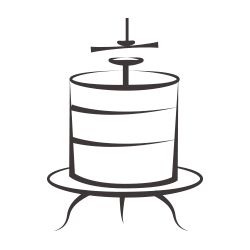The refined elegance of a Firriato Etna DOC
Cavanera Contrada Verzella - Ripa di Scorciavacca
Etna DOC
Carricante, Catarratto
Cavanera Contrada Verzella is a Cru Bianco Etna DOC that encapsulates the intense and refined bouquet, showcasing the scents and complexity of a unique terroir in the Sicilian viticultural landscape, the Etna volcano. From the winter rigors of the high mountains to the lushness of vines cultivated in full sunlight, an elegant white wine by Firriato emerges from the union of Carricante and Catarratto grapes, sourced from a single vineyard meticulously tended to benefit from its privileged microclimate.
The “young” soils are particularly fertile due to the high concentration of nutrients, coupled with agronomic practices such as leaf removal and vine vigor promotion, imparting a distinct character and balance between acidity and smoothness. This results in an extraordinary potential for longevity, making it a wine of remarkable depth and finesse.
Cavanera Contrada Verzella is a Cru Bianco Etna DOC that encapsulates the intense and refined bouquet, showcasing the scents and complexity of a unique terroir in the Sicilian viticultural landscape, the Etna volcano. From the winter rigors of the high mountains to the lushness of vines cultivated in full sunlight, an elegant white wine by Firriato emerges from the union of Carricante and Catarratto grapes, sourced from a single vineyard meticulously tended to benefit from its privileged microclimate.
- Appellation: Etna DOC
- Vine: Carricante, Catarratto
- Terroir: mountain
- Soil: volcanic soils , highly draining
- Exposure: sud (from 600 to 750 mt. a.s.l)
- Contrada Verzella
Production Area
Etna – Contrada Verzella

Located in the northeastern part of Volcanic Etna, Contrada Verzella experiences generally low winter temperatures, with significant temperature variations between day and night. This unique climate of the soil and the environment enhances the complexity of the fragrances found in the grapes.
About wine
Cavanera Contrada Verzella
Federico Lombardo di Monte Iato, Marketing & Communication Manager at Firriato, introduces us to the Cavanera Contrada Verzella – Ripa di Scorciavacca, a “contrada” white wine born at the foothills of Europe’s tallest active volcano. Characterized by a predominant portion of Carricante, a native white grape variety of Mount Etna, and a small portion of Catarratto, the Cavanera Contrada Verzella is a splendid expression of Etna’s viticulture, carrying all the scents and organoleptic components typical of the Etna terroir.
THE WINE IN 3 WORDS: Mineral, fresh, powerful.
FUN FACT: We call it a “contrada” wine as it is produced from a Cru, a specific vineyard located in the Verzella district on the north side of the volcano. The vineyard from which it originates has an average age of about 80 years.

Cavanera Contrada Verzella
A mountain climate in the Mediterranean climate zone
Cavanera on Etna is a unique cultivation environment within Sicily. The interaction between the mountain climate that defines Etna, the estate’s sunlight levels at 600-900 metres altitude, and the dark soils of volcanic origin, determines the high temperature difference between day and night. The rich soil skeleton of the volcanic earth allows the vines’ roots to penetrate deep down, naturally favouring the plants’ strength. The Catarratto and Carricante grapes that grow on Etna are distinguished by their sensory complexity and elegant minerality. Among the farming practices used in the Ripa di Scorciavacca vineyard Firriato uses the procedure of leaf removal on the vines. Practices such as this in the vineyard, favour the full ripening and the concentration of aromas in the grapes. The combination of these unique conditions goes to produce a wine that is the complete and natural embodiment of such an incomparable landscape.
Cavanera Contrada Verzella
The characteristics of vintages
2022
In the northeast area of the volcano, plant growth was characterized by a mild spring with limited rainfall, followed by an exceptionally dry summer. These conditions favored an excellent grape ripening on Mount Etna. Harvest began in mid-August for the international varieties cultivated near the sea and later in mid-September on Mount Etna with the harvesting of Carricante and Nerello Mascalese for the production of rosé wines.
2021
During 2021, after a mild spring, the sirocco showed its strength, causing a reduction in rainfall and bringing the harvest forward by about a week. Despite a slight drop in production, largely attributable to the altitude and exposure to northern winds, the quality of the grapes was excellent. The wine obtained is characterized by its olfactory refinement and an acid and mineral balance which makes it extremely pleasant on the palate.
2020
On Etna a harvest to remember, the best of the last five years. More than favorable picture; in late May, there was an almost total absence of rainfall together with a consistent decrease in rainfall – during the second ten days of June – which led to an earlier harvest, bringing the harvest time back by about a week compared to 2020.
2018
The climatic trend of the first months of 2018 was characterized by mild winter and average temperatures recorded over spring season. On the contrary, summer was marked by rain and bad weather. Rainfall was more abundant and particularly in June, the wettest month of the last thirty years, according to regional averages.
2017
On the north slope of the Etna volcano, grape harvest started a week before compared to 2016. Carricante grapes had been harvested in advance with healthy bunches but a drop in production by 10%. High temperature physiolocgically slowed down the vines, but September rainfalls caused a temperatures drop easing the vine recovery. This climate situation implicated a good sugar maturation of the Nerello Mascalese grapes yet to be collected. The Etna grape harvest finished in the middle of October.
2016
Grape harvest achieved extraordinary results on the Etna volcano. Cool summer with reduced rainfalls set ideal conditions for obtaining quality grapes. Grape harvest began about a week earlier than usual and ended about a week earlier on schedule, avoiding the rains of October.
2015
The winter was hard with heavy rainfall, also the spring was very rainy with temperatures below the seasonal average, this has led to a budding more late. Excellent was the vegetative growth of the high temperatures of May and June have exploited for a splendid flowering followed by a good fruit set. The hailstorm that hit June 9 reported fortunately little damage limited to vegetation.
2014
The climate was crucial for the quality of the produced grapes, after the spring rains and early summer, the temperatures have gradually approached the seasonal average, but no heat spikes. Finally there was a return to a more vintage style Etna.
2013
The year showed to be fruitful. Either regarding the quantity, and definitely regarding the quality “very interesting wines regarding the aromatic profile” had been obtained. Because of the climate, the harvest lasted till the last week of September. The year 2013 gave a slower harvest and then a gradual maturation.
2012
This vintage benefited from favourable weather conditions, resulting in excellent and exquisite ripening of the local grape varieties Carricante and Catarratto. Winter on the north-eastern side of the volcano was cold with scarce rainfall and it was followed by a spring with average temperatures, thus preparing the vines well for an optimum yield.
2011
The weather conditions were fairly stable, resulting in a winter with average temperatures and less rainfall compared to previous years. Rainfall was plentiful during the spring months, preparing the vines well as they went on to produce healthy grapes of optimum ripeness. However, the harvest, which was performed by hand during the middle and last third of October, recorded a drop in production of 15% due to reduced bunch size. In terms of quality, there is no doubt that it was an excellent year.
2010
The climate in 2010 was distinguished by a winter with average temperatures and scarce rainfall and a mild and not very wet spring. The dry summer season hinted that the fruit may not match up to its usual level of perfection, but thanks to timely rainfalls at the end of September, the harvest did not fail to meet expectations. The harvest period was marked by cool temperatures, ranging from 20 to 22°C, with abundant rain.
2009
Bud break occurred later than in previous years thanks to the favourable weather conditions in 2009. Autumn was distinguished by fairly wintry weather and abundant rainfall, which was also frequent in the spring. The growth of the vines slowed down considerably during this first stage, then proceeded as normal in the very warm and humid summer months.


CAVANERA CONTRADA VERZELLA
Awards
2023
Gambero rosso: 3 Red glasses
Vini Buoni d’Italia: Crown
2022
Gambero rosso: 3 Red glasses
2021
Gambero rosso: 3 Red glasses
2020
James Suckling: 93 pts
Gambero rosso: 3 Red glasses
2017
James Suckling: 94 pts
Gambero rosso: 3 Red glasses
Vini Buoni d’Italia: Golden Star
2016
James Suckling: 93 pts
Vini Buoni d’Italia: 3 Stars
Wine Hunter: Wine hunter award Gold
Gambero rosso: 2 Red glasses
Luigi Veronelli: 2 Red stars
Bibenda: 4 Green Bunches
Wine Spectator: 88 pts
2015
James Suckling: 92 pts
Vini Buoni d’Italia: 4 Stars
Bibenda: 4 Green clusters
2014
Vini buoni d’Italia: 1 crown
2013
Bibenda: 3 Green clusters
Luigi Veronelli: 2 Red stars
2012
Luigi Veronell: 3 Red stars
Bibenda: 4 Green clusters
2009
Annuario dei Migliori Vini Italiani: 92 pts.
Bibenda: 4 Clusters
Robert Parker: 90 pts.
Paired with
Tagliolino (noodles) with red Mazara prawn tartar and seasonal truffle flakes
Prepare the butter base, mixing the salted butter and normal butter by melting it in a pan. Add the black truffle flakes and leave to flavor in the fridge for about 24 hours.




















